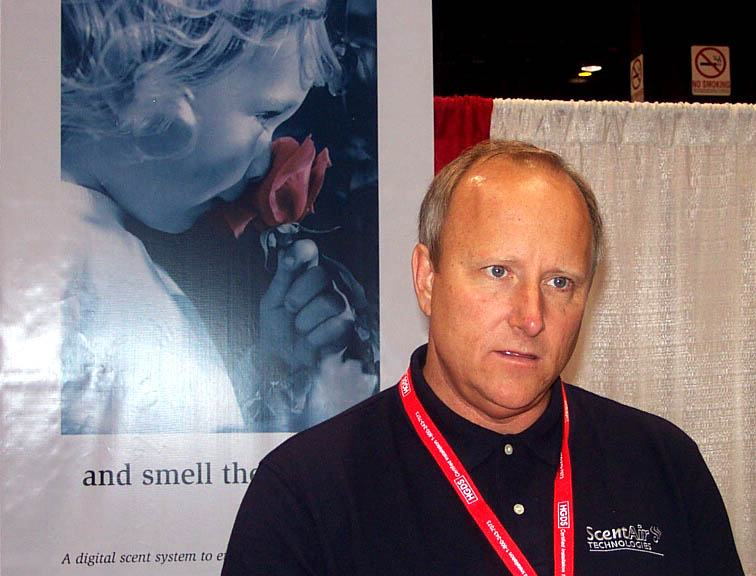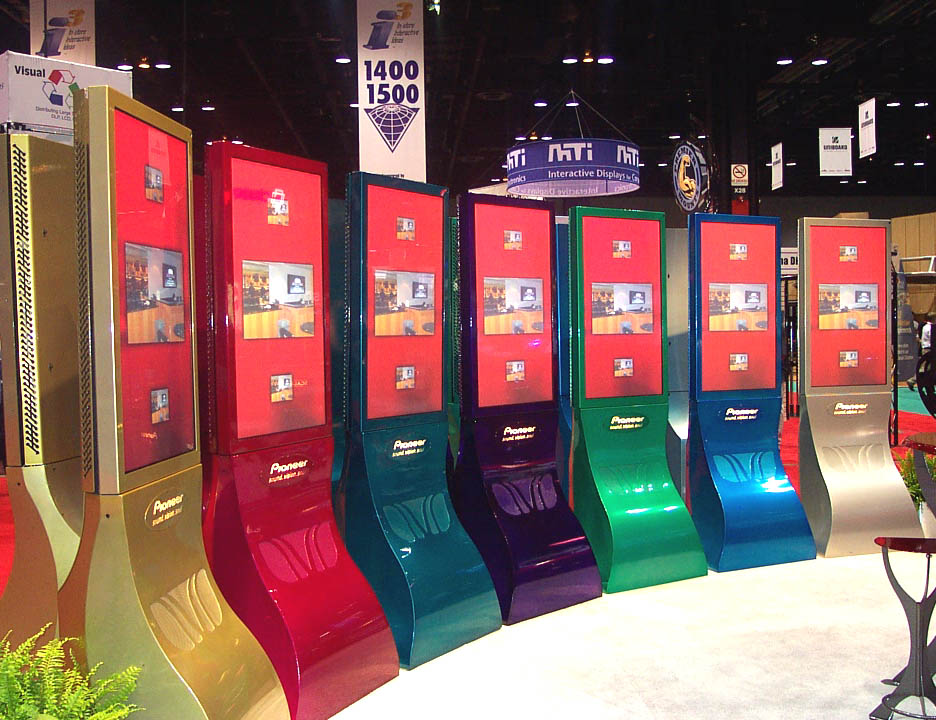Article
Giant GlobalShop keeps kiosks cornered
Kiosks made their presence felt at major trade show despite being shuffled to the back of the exhibit hall.
March 27, 2003
CHICAGO -- As trade shows go, GlobalShop is a giant. It annually occupies the largest exhibit hall in the country, Chicago's McCormick Place, bringing upwards of 1,000 exhibitors and 15,000 guests. It is a place where, at day's end, the cab line queues resemble those for roller coasters at crowded amusement parks.
Inside, you find what makes retail rock. There is lots of laminate and lighting, a sea of signage and more mannequins than you can imagine. This is the place to find buyers for boxes and shoppers for shopping carts. It offers a cornucopia of packaging and plastics options.
The show sits on two sides of a main aisle at McCormick. Take a right and wind your way past an ocean of opulent exhibits, and, keep going now, all the way to the end. In the back is what is known here as I3, for In-Store Interactive Ideas, and it is the place where the kiosk industry puts its best foot forward in its most promising segment -- retail.
There are 26 exhibitors here, less than 3 percent of the show's show-ers, and it is not exclusively kiosk-related companies. There is a builder of Web sites for stores, signage companies, and display makers. But there are also giants and would-be giants of the kiosk industry. Frank Mayer & Associates Inc. has the smaller of its two booths here, and kiosk manufacturers Apunix Computer Services and Arral Industries Inc. are sharing a booth. Nearby, Netkey Inc. is well-represented, and familiar names in the kiosks.org Association (KOA) such as Telpar Inc., Southwest Fixture Installers, Brown Innovations Inc., Infinite Peripherals Inc., Kiosk Magazine, MTI Inc., and Visual Productions Inc. are also represented at the show.
For the first time, the KOA has a booth that attracts plenty of interest, including attention from several kiosk-related exhibitors not aware that such an organization exists.
Here are a few other fascinating facts and figures from the trade floor, discovered by your humble editors, one of whom courageously traveled to Chicago and throughout the show alternated between bursts of speed in hops on crutches and a limping gait that made it seem like we were driving the speed limit on Chicago's treacherous highways. (The injured party was KIOSKmarketplace editor John Harrell, who sustained an achilles tendon injury two days before the show playing Australian Rules Football.)
The Forrest of Fragrance
No one on the show floor believed in his product more than Forrest Fleming, chief executive officer of ScentAir Technologies. Flowers and oranges adorned the small booth where Fleming pushed his system that delivers pleasing scents into any environment.
 |
ScentAir Technologies Chief Executive Officer Forrest Fleming spent GlobalShop preaching an aromatic gospel. |
Fleming is looking for a kiosk manufacturer to wake up and smell the power of his product. It is a device that sends a forced-air scent that adds to the kiosk experience.
"Smell will stop them," said Fleming, with a band of onlookers as evidence.
He said his patented provider of scent can be added to a kiosk for $75 and can be triggered like any other function. The first kiosk test is an application at a Las Vegas casino that sends out the smell of chocolate as a gambler gets closer to the prize.
Give me three weeks
Give credit for the most striking visual display to a booth shared by Pioneer Electronics Inc. and Digital Factory.com. A rainbow of seven colorful kiosks, each with a vertical plasma screen housed in a tall enclosure, greeted visitors.
Jim Hackett, vice president of sales and marketing for California-based Digital Factory, explained that the enclosures and the furniture in the booth were the product of a frenzied production cycle, with the idea hatched three weeks prior at a trade show in Las Vegas.
"Everything in the booth was done in three weeks," said Hackett, who said his company is best known for its finishes on fire trucks and for working with Hollywood producers on feature films.
He said the idea for the booth was to show how changing the bezel (the surface surrounding the screen) with a metal, powder-coated cover could produce an attention-getting display for Pioneer's plasma screens.
Plenty of Plasma
Speaking of plasma screens, the technology that just a couple of years ago was a rare sighting in any setting has certainly reached a stage of ubiquity, as evidenced as GlobalShop. Especially in the I3 area, but throughout every section of the show floor, were a variety of plasma screens in a range of shapes and sizes.
Just two years ago, showing up at a trade show with even one plasma screen was enough to draw crowds curious not about your product, but at the clear images produced on the screen.
 |
Pioneer Electronics Inc. made a huge impression with its seven plasma screens units. |
In fact, during the show Active Light, a distributor of plasma screen displays shown impressively in a booth in the I3 area, announced plans to print and distribute a Digital Dynamic Signage Resource Directory to help promote the "plasma display industry." The directory, produced in association with manufacturer NEC Solutions Inc., will be available in June.
Metal urgency
Nestled away near the back of GlobalShop's POP (Point of Purchase) Marketplace section was a company showcasing its own kiosk.
Willits, Ca.-based Metal fx designed and built the shimmering metal kiosk, with a curved front panel and an embedded keyboard. The company, which specializes in building video game enclosures, has been knocking around the idea of branching into kiosks for several years, but has stepped up the discourse since the first of the year.
"We decided to step things up a bit," explained Rich Barnett, Metal fx sales manager. "We've talked with Summit Research Associates and some software developers in the (San Francisco) Bay area and we'll see where we can go."
Barnett said the company chose to have a booth in the POP section instead of I3 in order to reach its core clientele base. If the company does enter the kiosk-enclosure market, it will probably do so as a contract manufacturer, building to specs, rather than designing its own line of enclosures.
A Brick House
Another company whose product may be of interest to kiosk companies is Brickstream, an Arlington, Va.-based startup. Brickstream, which launched its first products in January, tracks store traffic by placing cameras in the ceiling of a retail operation.
"We want retailers to look at the store at the macro level," explained Simon Angove, Brickstream vice president of sales and marketing. "We want them to know where people walked, where people stopped. We want to teach them where to place impulse buys, the impact of signage, and where to place destination products."
According to Zohor Karu, the firm's director of product development, the system also helps store executives analyze traffic patterns and what he called "walking velocities" that aid store planners in deciding where kiosks will be most successful.
Karu, a native of India raised in Alabama, said the product is being used by a major bank to track branch traffic.
Technology's Role in Retail
Kiosks have not made it to the marquee of GlobalShop's extensive seminar schedule, but there is certainly an awareness of their role. Dan Hopping, an IBM executive focused on cutting-edge developments, predicted the emergence of Bluetooth technology, a topic of much kiosk industry speculation, will provide massive change in the next three years.
Hopping, who foresees advances in voice recognition, translation, and handwriting recognition changing our daily lives soon, predicted that more change would occur in the next five years than in the last 20. To understand the impact of that prediction, he asked a packed house of several hundred to imagine life without cell phones, e-mail or the Internet, technologies which seemed futuristic in 1982.
Hopping said technology is now creating computer chips that pay for fast food, earrings that are also phones and a computer you wear on your body. If that is not Maxwell Smart enough for you, he said a wristwatch will be available that packs more computing punch than a device that required an entire room 20 years ago.
Then, some would say, Hopping went off the deep end, discussing projects that are actually on the drawing board at IBM. Is the world ready for a computer that reads your mind? Hopping said tests are underway on machines that interpret meaning from a user, who doesn't move or speak.






